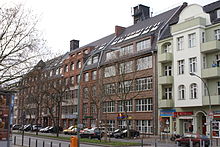Gronau & Graul
Gronau & Graul was a German architecture - office with a predominant sphere in Old Berlin . Business partners Max Gronau and Wilhelm Graul took part in the building boom in the up-and-coming city of Berlin at the beginning of the 20th century.
history
Max Gronau was the son of the factory owner Leopold Gronau. He most likely studied architecture at the Technical University of Charlottenburg . Max Gronau inherited the apartment building at Alexandrinenstraße 97 and ran an architecture office in the same house towards the end of the 19th century (Gronau & Co. GmbH) . In the following years he teamed up with the architect and master mason Willy (= Wilhelm) Graul, who initially traded as an architect in Niederschönhausen (Lindenstrasse 12) (1898) and in 1900 had operated a blueprint and architectural studio . From then on they appeared as Gronau & Graul in tenders and on the market. The Graul family moved into their apartment at Mathieustraße 2.
In 1908 the residence of the architect Wilhelm Graul was at Wilmsstrasse 13. He was married to Margarete. In 1917, in the penultimate year of World War I , Wilhelm Graul was drafted into the military and died there.
Both were members of the Association of German Architects .
In the years after the Second World War , Max Gronau continued to work as an architect but without a partner and had his office on Alexandrinenstrasse.
Works (selection)
- In 1904, Gronau & Graul planned and built the Hotel Splendid at Dorotheenstrasse 37, which is now a listed building.
The architects had designed the hotel in the style of the South German Baroque with echoes of Art Nouveau . A particularly striking structural detail of the four-story house is the two-axis central risalit with a wide portal framed by atlases and caryatids at the level of the fourth floor under the very sculptural gable.
Between 1925 and 1933 the Red Aid of Germany was also located in the house, chaired by Wilhelm Pieck . A commemorative plaque attached to the GDR commemorated this activity. Until 1990, the building housed the Agriculture and Food Industry Bank . - For the factory founded in 1890, burning thickness and Ernst Scharnke in Oberbaumstraße 10 Gronau & Graul built in 1909 in the Silesian road 42 one office building , also a listed building.
- 1912–1914: The Prussian Central-Boden-Credit AG building at Friedrichstrasse 154 was also built according to designs by Gronau & Graul.
The hotel and bank building were part of the building ensemble between Unter den Linden 1/2, Friedrichstrasse and Mittelstrasse.
- In 1915/1916 Max Gronau (now without his passenger) built a new central wing and added storeys to the workshop building for the Carl Bamberg workshops for precision mechanics and optics ( Askania Werke ) .
Individual evidence
- ↑ Alexandrinenstrasse 97 . In: Address book for Berlin and its suburbs , 1900, III, p. 15. "Gronau, L., Fabr.bes." (In the 1899 address book the factory is more precisely described: an account book factory, book printing, and paper, stationery and wood goods engros The managing director is named Leopold Gronau.).
- ↑ Alexandrinenstrasse 97 . In: Address book for Berlin and its suburbs , 1900, III, p. 15.
- ^ Graul, W., Architect . In: Address book for Berlin and its suburbs , 1898, Part I, p. 396.
- ↑ Graul, Willy . In: Address book for Berlin and its suburbs , 1900, I, p. 462.
- ↑ Alexandrinenstrasse 97 . In: Berliner Adreßbuch , 1904, III, p. 16. “Gronau & Graul, Architecturbüro”.
- ^ Graul, W., master builder . In: Berliner Adreßbuch , 1904, I, p. 551.
- ^ Graul, Wilh., Architect . In: Directory of participants in telephone networks in Berlin and the surrounding area , 1908, p. 391.
- ↑ Graul, Margarete . In: Berliner Adreßbuch , 1918, Part I, p. 826. “Wilmsstrasse 13”.
- ↑ Information on the architect Wilhelm Graul. Private homepage; Retrieved July 25, 2015.
- ↑ Gronau & Graul . In: Berliner Adreßbuch , 1910, Part I, p. 842 (Architects BDA).
- ↑ Gronau, Max . In: Berliner Adreßbuch , 1920, I. “Alexandrinenstraße 97” (Freiherr-vom-Stein-Straße 15 in Schöneberg is given as the apartment ).
- ↑ Architectural monument Dorotheenstrasse 37, Hotel Splendid, 1904 by Gronau & Graul
- ↑ Institute for Monument Preservation (Ed.): The architectural and art monuments of the GDR. Capital Berlin-I . Henschelverlag, Berlin 1984, p. 198 .
- ↑ Monument Schlesische Straße 42, office building, 1909 by Gronau & Graul; Factory, 1890 by R. Brenndicke and Ernst Scharnke, Oberbaumstrasse 10
- ↑ Architectural monument Preussische Central-Boden-Credit AG, 1912–1914 by Gronau & Graul, Friedrichstrasse 154 / Mittelstrasse 55
- ↑ Baudenkmal complex workshops for precision mechanics and optics Carl Bamberg (Askaniawerke) ; Erected by Kreuschmer & Co. in 1887/1888 ; 1915/1916 extension and middle wing by Max Gronau; Hans Altmann continued to expand until 1937

